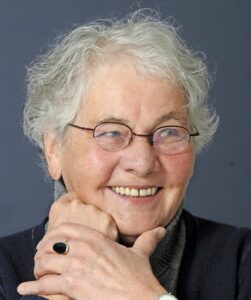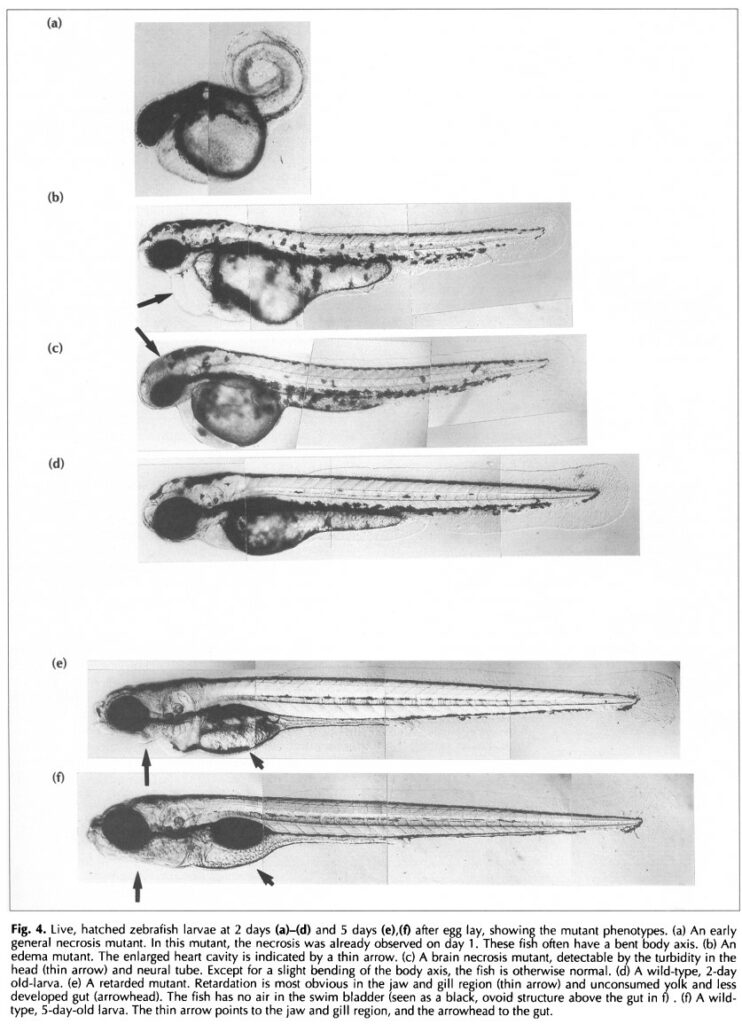In March we celebrate women’s history. And we have taken this great celebration to highlight important women in the history of aquatic models research, especially zebrafish and xenopus. Every Friday of this month, we will publish one article on the fantastic discoveries made by a woman.
Today we are honored to present to you Prof. Christiane Nusslein-Volhard, a german developmental biologist and Nobel laureate.
Biography
Christiane Nüsslein-Volhard was born on October 20, 1942 in Frankfurt. Her father was an architect and her mother a painter (1). From an early age, she was interested in the field of biology. She said “I think I knew at the age of twelve at the latest that I wanted to be a biologist” (1). Christiane enjoyed school because she learned a lot about plants and animals.
However, her first year in Frankfurt University was disappointing because she thought that courses were boring. Fortunately, a new curriculum for biochemistry started in Tübingen and she decided to be a student in this city. She passed the exams for the diploma in Biochemistry in 1969 (1). And in 1973 she earned a PhD in genetics (2).
When the Friedrich-Miescher Laboratory was founded, she began to be interested in pattern formation and she decided to do a postdoctoral project about mutations in flies (Drosophila melanogaster) egg cells. She later continued her project in Basel at the Biozentrum (1).
In 1981, she accepted a junior position at the Friedrich-Miescher-Laboratory of the Max-Planck-Society in Tübingen and was still working on Drosophila mutants (1).
From 1985 until 2014 she was the director of an independent section at the Max-Planck Institut (1,2). And it was at this moment when she brought the first zebrafish tank to the lab. Her lab was focusing on pattern formation, growth and cell migration in the zebrafish (1). In September 1992 the lab counted with 7’000 tanks. She and her team used zebrafish to publish manuscripts describing 1’200 zebrafish mutants (1).

In 1995 she received the Nobel Prize in Physiology or Medicine for the discovery of genes that control the development in animals and humans, and the demonstration of morphogen gradients in the fly embryo (1,2).
In 2004 she founded the Christiane-Nüsslein-Volhard-Fundation in order to support women with children in science (1,2).
Her contribution to zebrafish research
Prof. Christiane Nüsslein-Volhard studied pigment patterns formation in vertebrates, using zebrafish as model organism (3). She used zebrafish because their color patterns are variable between individuals. The goal of her study was to understand the genetic basis of color pattern variation between zebrafish individuals as well as the evolution of color pattern in other vertebrates (3).
Her research is of great relevance as understanding color patterns can help to better understand evolution and selection. In fact, color patterns are essential in many species because they play a particular role in predation and reproduction.

During her career, she wrote 75 articles that were published (available on PubMed), and 54 of which are about zebrafish.
Her two last articles were published in 2022. The first, called “M-CSFR/CSF1R signaling regulates myeloid fates in zebrafish via distinct action of its receptors and ligands”, is about a specific signalling pathway (CSF1R) in zebrafish. Understanding these pathways and signalling may set the basis for new therapeutic targets related to many human diseases, such as cancers and neurological disorders (4). The second article, “Developmental genetics with model organisms” teaches us about the origins of model organisms in genetics and explains their importance and usefulness in research (5).
Conclusion
Through this work, Christiane Nüsslein-Volhard has discovered many of the mechanisms of maternal effect genes in Drosophila. By working with zebrafish, she affirmed the place of this organism as a model in genetics and highlighted numerous developmental mechanisms.
References
- The Nobel Prize in Physiology or Medicine 1995 [Internet]. NobelPrize.org. [cited 2023 Feb 28]. Available from: https://www.nobelprize.org/prizes/medicine/1995/nusslein-volhard/biographical/
- Lebenslauf [Internet]. [cited 2023 Feb 28]. Available from: https://www.bio.mpg.de/183895/lebenslauf
- Christiane Nüsslein-Volhard [Internet]. [cited 2023 Feb 28]. Available from: https://www.bio.mpg.de/86965/nuesslein-volhard
- Hason M, Mikulasova T, Machonova O, Pombinho A, van Ham TJ, Irion U, et al. M-CSFR/CSF1R signaling regulates myeloid fates in zebrafish via distinct action of its receptors and ligands. Blood Adv. 2022 Mar 2;6(5):1474–88.
- Irion U, Nüsslein-Volhard C. Developmental genetics with model organisms. Proc Natl Acad Sci U S A. 2022 Jul 26;119(30):e2122148119.
- Kastilan S. Die Nobelpreisträgerin Christiane Nüsslein-Volhard wird 80 – Bild 1 von 1. FAZNET [Internet]. 2022 Oct 20 [cited 2023 Mar 2]; Available from: https://www.faz.net/aktuell/feuilleton/debatten/nobelpreistraegerin-christiane-nuesslein-volhard-wird-80-18398868.html
- Mullins MC, Hammerschmidt M, Haffter P, Nüsslein-Volhard C. Large-scale mutagenesis in the zebrafish: in search of genes controlling development in a vertebrate. Curr Biol. 1994 Mar 1;4(3):189–202.
- First picture : The Nobel Prize | Women who changed science | Christiane Nüsslein-Volhard [Internet]. [cited 2023 Mar 1]. Available from: https://www.nobelprize.org/womenwhochangedscience/stories/christiane-nusslein-volhard



